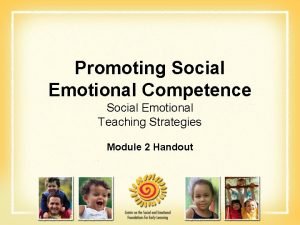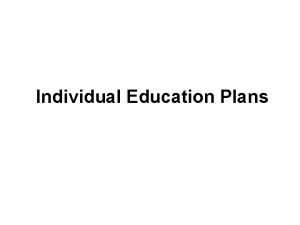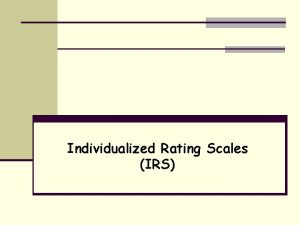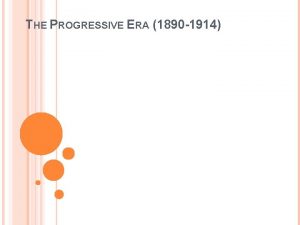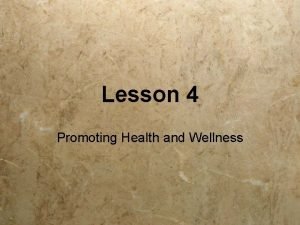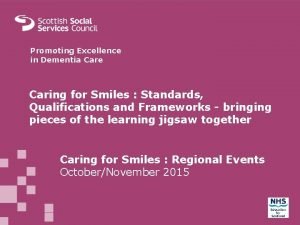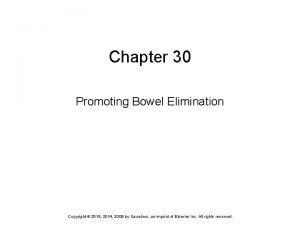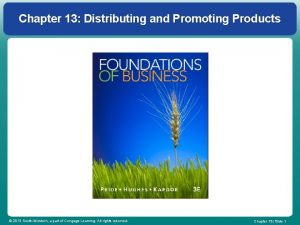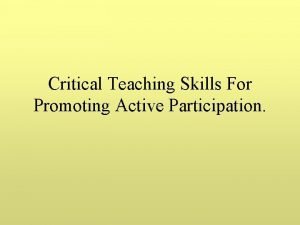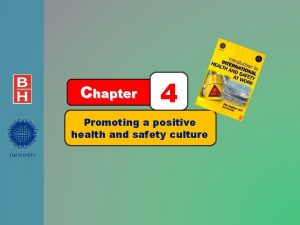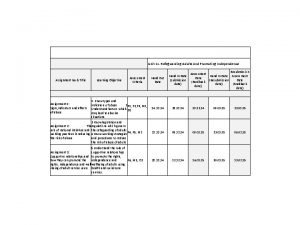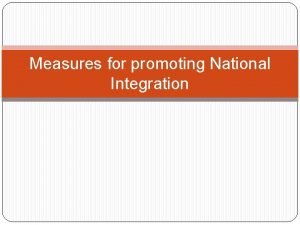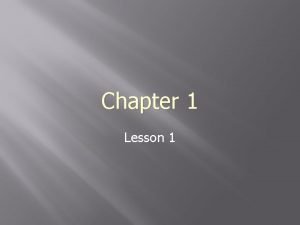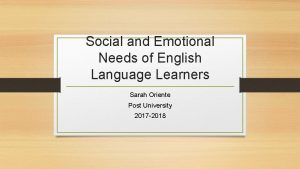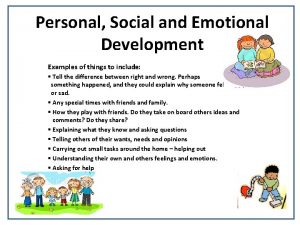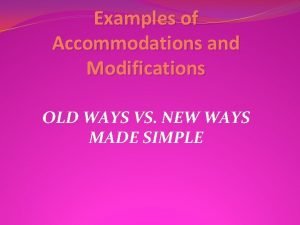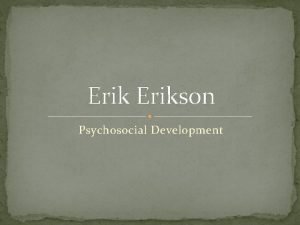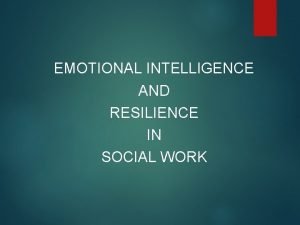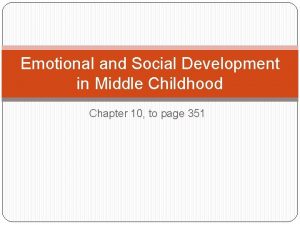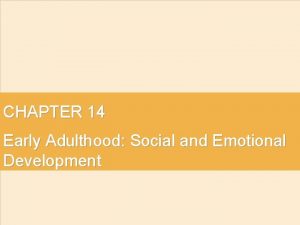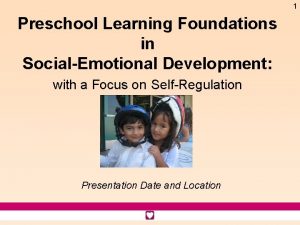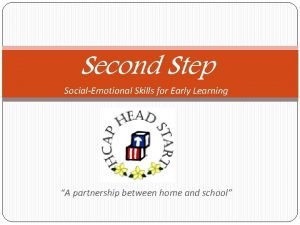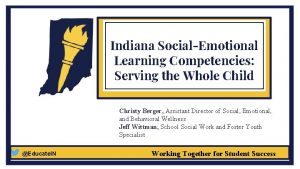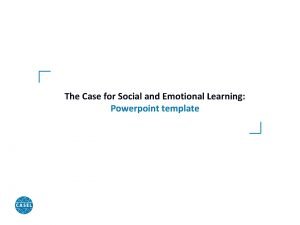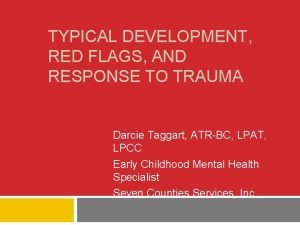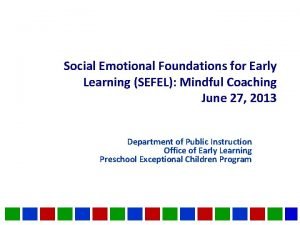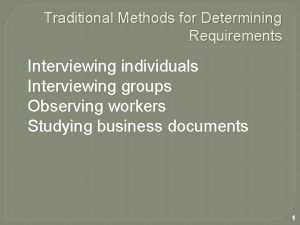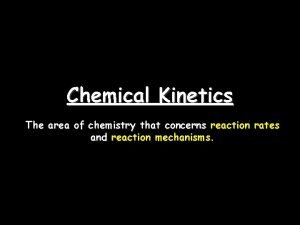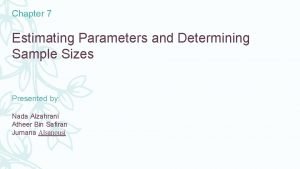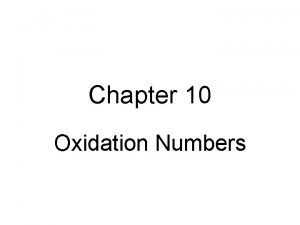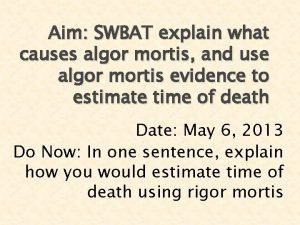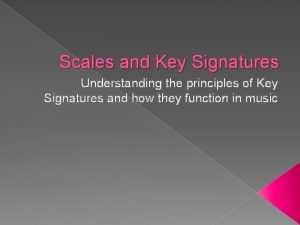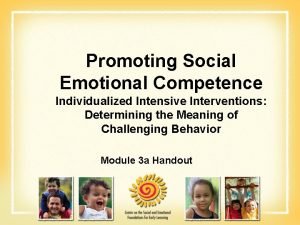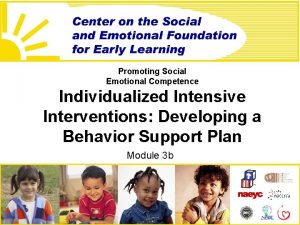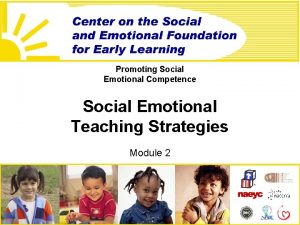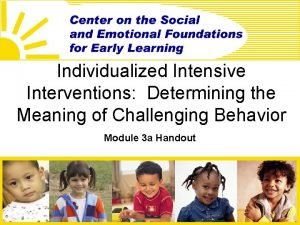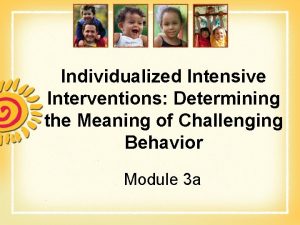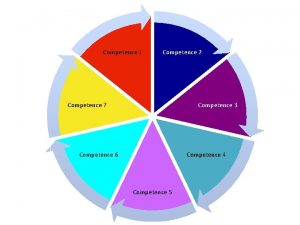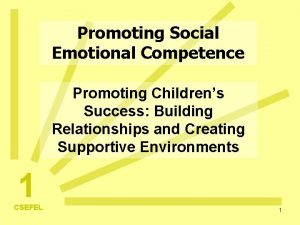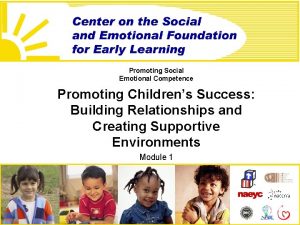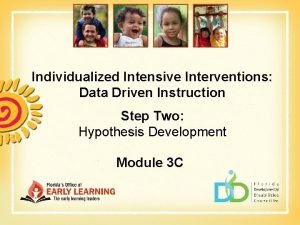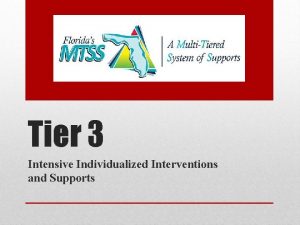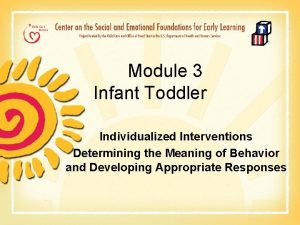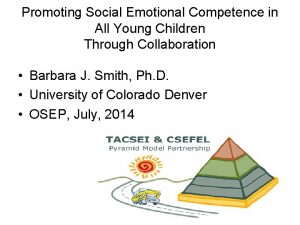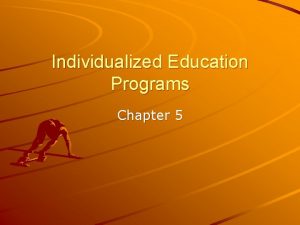Promoting Social Emotional Competence Individualized Intensive Interventions Determining






































































- Slides: 70

Promoting Social Emotional Competence Individualized Intensive Interventions: Determining the Meaning of Challenging Behavior 3 a CSEFEL 1

Agenda 3 a CSEFEL • Introduction • Challenging Behavior • Overview of PBS • Behavior Equation • The Process of PBS, Building a Team • Introduction to Functional Assessment • Functional Assessment Observation • Conducting Observations, Data to Collect • Functional Assessment Interview • Case Study Activity: Determining the Function • Hypothesis Development • Not Sure about The Hypothesis 2

Learner Objectives This workshop will teach you to: • • • 3 a CSEFEL • Define forms and function of communication and identify the behavioral mechanisms that contribute to viewing challenging behavior as communicative. Describe methods that may be used to determine the function of challenging behavior. Use interview and observation data to determine the communicative function of challenging behavior. Develop a behavior hypothesis from functional assessment information. 3

Challenging Behavior What we are referring to when we say “challenging behavior” is: • • • 3 a CSEFEL Any repeated pattern of behavior that interferes with learning or engagement in prosocial interactions with peers and adults. Behaviors that are not responsive to the use of developmentally appropriate guidance procedures. Prolonged tantrums, physical and verbal aggression, disruptive vocal and motor behavior (e. g. , screaming, stereotypy), property destructions, self-injury, noncompliance, and withdrawal. 4

5

Promoting Social Emotional Competence Individualized Intensive Interventions Social Emotional Teaching Strategies Creating Supportive Environments Building Positive Relationships 6

Intensive Individualized Instruction 3 a CSEFEL Intensive individualized instruction and interventions are used with children who have very persistent and severe challenging behavior and do not respond to the typical preventive practices, child guidance procedures, or social emotional teaching strategies that would normally work with most children. 7

Old Way • General intervention for all behavior problems • Intervention is reactive • Focus on behavior reduction • Quick Fix 3 CSEFEL New Way • Intervention matched to purpose of the behavior • Intervention is proactive • Focus on teaching new skills • Long term interventions 8

Challenging Behavior Communicates May be used to communicate a message when a child does not have language 3 a CSEFEL 9

Challenging Behavior Communicates May be used instead of language by a child who has limited social skills or has learned that challenging behavior will result in meeting his or her needs 3 a CSEFEL 10

Challenging Behavior • Children engage in challenging behavior because “it works” for them. • Challenging behavior results in the child gaining access to something (i. e. , obtain) or avoiding something (i. e. , escape). 3 a CSEFEL 11

Children Communicate a Variety of Messages 3 a CSEFEL • Forms of communication –Words –Sentences –Eye gaze –Pulling adult –Crying –Biting –Tantrums –? –? 12

Children Communicate a Variety of Messages 3 a CSEFEL • Functions of communication –Request object, activity, person –Escape demands –Escape activity –Request help –Request social interaction –Comment –Request information –? –? 13

Evan is playing with Duplos. He tries to attach a block to his stack of 3. He can’t quite get the blocks to connect. He looks up at a teacher and begins fussing. He holds the stack of blocks up, looks at the blocks, and looks at the teacher. The teacher helps him put the blocks together. 3 a CSEFEL 14

Shana 3 a CSEFEL Shana is sitting in her high chair with nothing on the tray. Her mother is stirring her oatmeal. Shana begins crying and bangs her head on the back of the seat. Her mother says to her, "It's not cool enough, honey, just a minute. " Shana stops crying when the oatmeal is placed on her tray. 15

Christina wanders into the kitchen where her mother is cooking. She looks around the kitchen and at the tray of her high chair. She moves to the refrigerator and looks at her mom. She begins crying and reaching toward the refrigerator. Her mother takes out a bottle, warms it, and gives it to her. 3 a CSEFEL 16

Tim 3 a CSEFEL Tim is riding a trike on the bike path. He sees a child move to the sandbox where he had just finished building a road-way. He leaps off his trike and tackles the child. He hits the child. A teacher comes over to intervene. She comforts the child, and scolds Tim goes to the sandbox and continues construction on his road-way. 17

Madison 3 a CSEFEL Madison is in housekeeping, putting on high heels and a hat. Emily moves into the area and selects a purse from the dress-ups. Madison shouts “no” and bites Emily. A teacher comes over, she asks Madison to go to the thinking chair and takes Emily to the bathroom to look at the bite. After 4 minutes, Madison leaves the thinking chair and returns to housekeeping. She grabs the purse Emily had selected and continues to play. Emily leaves the bathroom with the teacher and then begins an art activity where the teacher is present. 18

Kyra 3 a CSEFEL Kyra sees three children playing with the train set. She watches them carefully. She grabs one of the trains and holds it. The children call for a teacher. The teacher comes over, asks about what happened, and then prompts Kyra to ask to play. Kyra complies and joins the group. The children reluctantly allow her to join the group. 19

Trigger Behavior Joey is asked Joey resists, to come to cries, and hits circle. Teacher teacher provides physical prompt to move him to group. Maintaining Consequence Teacher moves away from Joey and allows Joey to select a different activity. 20

Setting Event that occurs at another time that increases the likelihood the child will have challenging behavior. Setting events serve to “set the child up” to have challenging behavior. 3 a CSEFEL 21

Setting Event Trigger Behavior Maintaining Consequence Quan approaches computer and sees child working on program. Quan moves his picture to indicate that he is next. Quan observes and waits for his turn. Child leaves computer and Quan sits down and begins working. 22

Setting Event Quan was up most the night with an asthma attack. He arrives at school looking sleepy and with dark circles under his eyes. Trigger Quan approaches computer and sees child working on program. Behavior Maintaining Consequence Quan hits child and pushes his body on the child’s chair. Child leaves computer and Quan sits down and begins working. 23

Evan is playing with Duplos. He tries to attach a block to his stack of 3. He can’t quite get the blocks to connect. He looks up at a teacher and begins fussing. He holds the stack of blocks up, looks at the blocks, and looks at the teacher. The teacher helps him put the blocks together. 3 a CSEFEL 24

Shana 3 a CSEFEL Shana is sitting in her high chair with nothing on the tray. Her mother is stirring her oatmeal. Shana begins crying and bangs her head on the back of the seat. Her mother says to her, "It's not cool enough, honey, just a minute. " Shana stops crying when the oatmeal is placed on her tray. 25

Christina 3 a CSEFEL Christina wanders into the kitchen where her mother is cooking. She looks around the kitchen and at the tray of her high chair. She moves to the refrigerator and looks at her mom. She begins crying and reaching toward the refrigerator. Her mother takes out a bottle, warms it, and gives it to her. 26

Tim 3 a CSEFEL Tim is riding a trike on the bike path. He sees a child move to the sandbox where he had just finished building a road-way. He leaps off his trike and tackles the child. He hits the child. A teacher comes over to intervene. She comforts the child, and scolds Tim goes to the sandbox and continues construction on his road-way. 27

Madison 3 a CSEFEL Madison is in housekeeping, putting on high heels and a hat. Emily moves into the area and selects a purse from the dress-ups. Madison shouts “no” and bites Emily. A teacher comes over, she asks Madison to go to the thinking chair and takes Emily to the bathroom to look at the bite. After 4 minutes, Madison leaves the thinking chair and returns to housekeeping. She grabs the purse Emily had selected and continues to play. Emily leaves the bathroom with the teacher and then begins an art activity where the teacher is present. 28

Kyra 3 a CSEFEL Kyra sees three children playing with the train set. She watches them carefully. She grabs one of the trains and holds it. The children call for a teacher. The teacher comes over, asks about what happened, and then prompts Kyra to ask to play. Kyra complies and joins the group. The children reluctantly allow her to join the group. 29

Process of Positive Behavior Support Step 1: Establishing a team and identifying goals of intervention Step 2: Gathering information (functional assessment) Step 3: Developing hypotheses 3 a CSEFEL Step 4: Designing behavior support plans Step 5: Implementing, monitoring, and evaluating outcomes 30

Potential Team Members • Parents/Family • Teacher • Assisting Teacher/Paraprofessional • Therapists • Administrative Staff • Other 3 a CSEFEL 31

Process of Positive Behavior Support Step 1: Establishing a team and identifying goals of intervention Step 2: Gathering information (functional assessment) Step 3: Developing hypotheses 3 a CSEFEL Step 4: Designing behavior support plans Step 5: Implementing, monitoring, and evaluating outcomes 32

Functional Assessment A process for developing an understanding of a person’s challenging behavior and, in particular, how the behavior is governed by environmental events. 3 a CSEFEL 33

Functional Assessment 3 a CSEFEL • Observe the child in target routines and settings • Collect data on child behavior, looking for situations that predict challenging behavior and that are linked with appropriate behavior • Interview persons most familiar with the child • Review records 34

1 2 3 4 5 6 7 8 9 * 0 # 35

1 2 3 4 5 6 7 8 9 * 0 # 36

Name: General Context: Observer: Date: Time: Social Context: Behavior Problem: Social Reaction: 3 POSSIBLE FUNCTION: CSEFEL 37

Observation Vignette #1 38

Answer 39

Observation Vignette #2 40

Answer 41

Observation Vignette #3 42

Answer 43

Observation Vignette #4 44

Answer 45

Observation Vignette #5 46

Answer 47

Observation Vignette #6 48

Answer 49

Setting Event Data Collection 3 50

51

10/12 52

Activity Analysis Child: Rachel Routine/Activity: House Center Activity Description Behavior Expectations Steps: 1. Select materials 1. Pick materials that no one is using 2. Pretend in roles 2. Use materials appropriately Problems 3. Exchange materials with peers 3. Don’t take from peer 3. Takes materials from others 4. Follow peers’ lead or accept role assignment 4. Maintain engagement 4. Ignores peers, interferes in play 5. Clean-up 5. Put materials on shelf in correct area 53

Child: Rachel Routine/Activity: Snack Activity Description Activity Analysis Behavior Expectations Steps: 1. Sit in chair 1. Stay in seat 2. Take food from plate when passed 2. Take one item, wait for turn 3. Eat food on plate 3. Eat from own plate 4. Drink juice from own cup 4. Drink and put cup on table 5. Ask for more food 5. Ask if using please 6. Wipe face with napkin 6. Use napkin, not clothing 7. Throw plate/cup/napkin away when finished 7. Clear place, throw in trash Problems 2. Takes multiple items, puts hand in bowl, grabs while plate is passed 3. Takes food from other children’s plates 5. Grabs food when she wants more 54

Everybody Helps • Family collects data • Collect data in ALL settings 3 a CSEFEL 55

“KIS” • “KIS it” (Keep It Simple) Create simple, user-friendly forms to collect information (e. g. , rating scales, check sheets) 3 a CSEFEL 56

Home Observation Card This card can be used by families when doing observations 3 a CSEFEL 57

Functional Assessment Interview 3 a CSEFEL • Define behavior (describe what you see) • Describe frequency and intensity • Explore possible setting events • Identify predictors • Identify maintaining consequences • Identify current communicative functions • Describe efficiency of the behavior • Describe previous efforts • Identify possible reinforcers 58

Functional Assessment Interview Refer to sample of Jackson’s Functional Assessment Interview in handouts. 3 a CSEFEL 59

Working as a Collaborative Team 3 a CSEFEL • Assign roles • Determine agenda and time for meetings • Ensure group participation through facilitation and participatory processes 60

Roles • Facilitator – person who guides group in stating agenda, work goals, time allocation • Recorder – person who writes down the discussion • Time Keeper – Person who tracks time and warns when agenda item is ending • Reporter – person who shares group information, makes presentation • Encourager – person who provides feedback to group members • Jargon-buster – person who asks the question “what do you mean when you say ‘gobbley-gook’” and helps the group with communicating clearly 61

Determining the Function of Challenging Behavior 3 a CSEFEL • Assign roles • Review child description • Review observations • Review interview • Complete final page of interview • Determine functions of problem behavior • Report to group 62

Process of Positive Behavior Support Step 1: Establishing a team and identifying goals of intervention Step 2: Gathering information (functional assessment) Step 3: Developing hypotheses 3 a CSEFEL Step 4: Designing behavior support plans Step 5: Implementing, monitoring, and evaluating outcomes 63

Hypothesis Statement • • Description of the challenging behavior Predictors of the challenging behavior Purpose of the behavior Maintaining consequences 3 a CSEFEL 64

Hypothesis Statement 3 a CSEFEL Jackson avoids the demands of activities that he finds difficult (structured languagebased activities, sharing objects, interactive play) by resisting or withdrawing. If pushed to participate, Jackson will react by throwing objects, screaming, or stating “shut up. ” When he resists, adults will often give up or allow him to leave the activity. 65

Hypothesis Statement 3 a CSEFEL Billy will use tantrums to request a social interaction. Billy will initiate a chase game or request to be held by pulling the adult’s hand or positioning the adult. If the adult does not comply, Billy will cry loudly, scream, and bring his hands to his face or ears. Often the caregiver will comply with his request or pick him up. 66

Hypothesis Statement 3 a CSEFEL Marcia tantrums to escape moving to a new activity. When she is asked to transition from an activity (e. g. , playing in the sandbox) to another activity, she will whine, cry, pretend to vomit, slap at the adult, and scream. When she does this, the adult lets her stay a little longer with the original activity or picks her up kicking and screaming. 67

Hypothesis Development • Assign roles • Review functions as determined by your case study group • Write hypothesis statement on overhead or chart paper • Present to group 3 a CSEFEL 68

Not Sure about the Hypothesis? 3 a CSEFEL • What would make the challenging behavior stop? Is it something you would provide or allow the child access to? Or is it something to remove or allow the child to leave? • If still unsure, collect more data in the same context • Some challenging behaviors may have the same form, but serve multiple functions • Some problem behaviors may begin around one function (e. g. , escape) and continue to access something additional (e. g. , attention) 69

Summary 3 a CSEFEL • Challenging behavior has meaning for the child • The function of challenging behavior is defined by the context • Functional assessment is the formal process for determining the why (i. e. , function) of challenging behavior 70
 Tucker turtle takes time to tuck and think video
Tucker turtle takes time to tuck and think video Peter g schultz
Peter g schultz Individualized consideration
Individualized consideration Steve jobs intellectual stimulation
Steve jobs intellectual stimulation Individualized instruction vs differentiated instruction
Individualized instruction vs differentiated instruction Individualized education plan
Individualized education plan Individualized rating scale
Individualized rating scale Individualized family service plan example
Individualized family service plan example Center for individualized medicine
Center for individualized medicine Individualized healthcare
Individualized healthcare Promoting moral improvement
Promoting moral improvement Promote service arrange decide
Promote service arrange decide Promoting alternative thinking strategies
Promoting alternative thinking strategies Chapter 1 lesson 4 promoting health and wellness
Chapter 1 lesson 4 promoting health and wellness Promoting family earthquake preparedness
Promoting family earthquake preparedness Chapter 1 lesson 4 promoting health and wellness
Chapter 1 lesson 4 promoting health and wellness Promoting racial literacy in schools
Promoting racial literacy in schools Lesson 4 promoting health and wellness
Lesson 4 promoting health and wellness Leaving cert business philip curry
Leaving cert business philip curry Promoting infant health section 7-2
Promoting infant health section 7-2 Promoting excellence in dementia care
Promoting excellence in dementia care Example of deontology
Example of deontology Chapter 7 promoting health and wellness
Chapter 7 promoting health and wellness Chapter 30 promoting bowel elimination
Chapter 30 promoting bowel elimination Chapter 13 distributing and promoting products
Chapter 13 distributing and promoting products Promoting services and educating customers
Promoting services and educating customers Health promoting schools model
Health promoting schools model Promoting active participation
Promoting active participation Promoting a positive health and safety culture
Promoting a positive health and safety culture Unit 11 safeguarding adults and promoting independence
Unit 11 safeguarding adults and promoting independence National integration and international understanding
National integration and international understanding Explain the need for institutional support to entrepreneurs
Explain the need for institutional support to entrepreneurs Health promoting school
Health promoting school Japan's principal asset in promoting development is
Japan's principal asset in promoting development is Health and wellness vocabulary
Health and wellness vocabulary Social thinking social influence social relations
Social thinking social influence social relations Social thinking social influence social relations
Social thinking social influence social relations Sears assessment
Sears assessment Social emotional needs of ell students
Social emotional needs of ell students Personal social examples
Personal social examples General to specific words examples
General to specific words examples Social emotional development erikson
Social emotional development erikson Emotional intelligence in social work
Emotional intelligence in social work Social and emotional development in middle childhood
Social and emotional development in middle childhood Middle adulthood social development
Middle adulthood social development Emotional development of early adulthood
Emotional development of early adulthood Social emotional learning standards michigan
Social emotional learning standards michigan Preschool learning foundations social emotional
Preschool learning foundations social emotional Second step social emotional skills for early learning
Second step social emotional skills for early learning New jersey social emotional learning standards
New jersey social emotional learning standards Indiana sel competencies
Indiana sel competencies Indiana social emotional learning competencies
Indiana social emotional learning competencies Social and emotional wellbeing framework
Social and emotional wellbeing framework Social emotional learning standards washington state
Social emotional learning standards washington state Social emotional learning powerpoint template
Social emotional learning powerpoint template Social emotional observation checklist
Social emotional observation checklist Social and emotional foundations for early learning
Social and emotional foundations for early learning Emotional development in late adulthood
Emotional development in late adulthood Traditional methods for determining system requirements
Traditional methods for determining system requirements P and s wave chart
P and s wave chart Methods for determining molecular weight of polymers
Methods for determining molecular weight of polymers How to determine the rate determining step
How to determine the rate determining step What is the point estimate of μ?
What is the point estimate of μ? Margin of safety formula
Margin of safety formula Oxidation number rules
Oxidation number rules What causes algor mortis
What causes algor mortis Optimal level of product availability
Optimal level of product availability Systems analysis and design kendall
Systems analysis and design kendall Do not use key signature
Do not use key signature What is transport number in physical chemistry
What is transport number in physical chemistry Chardakov method lab report
Chardakov method lab report
